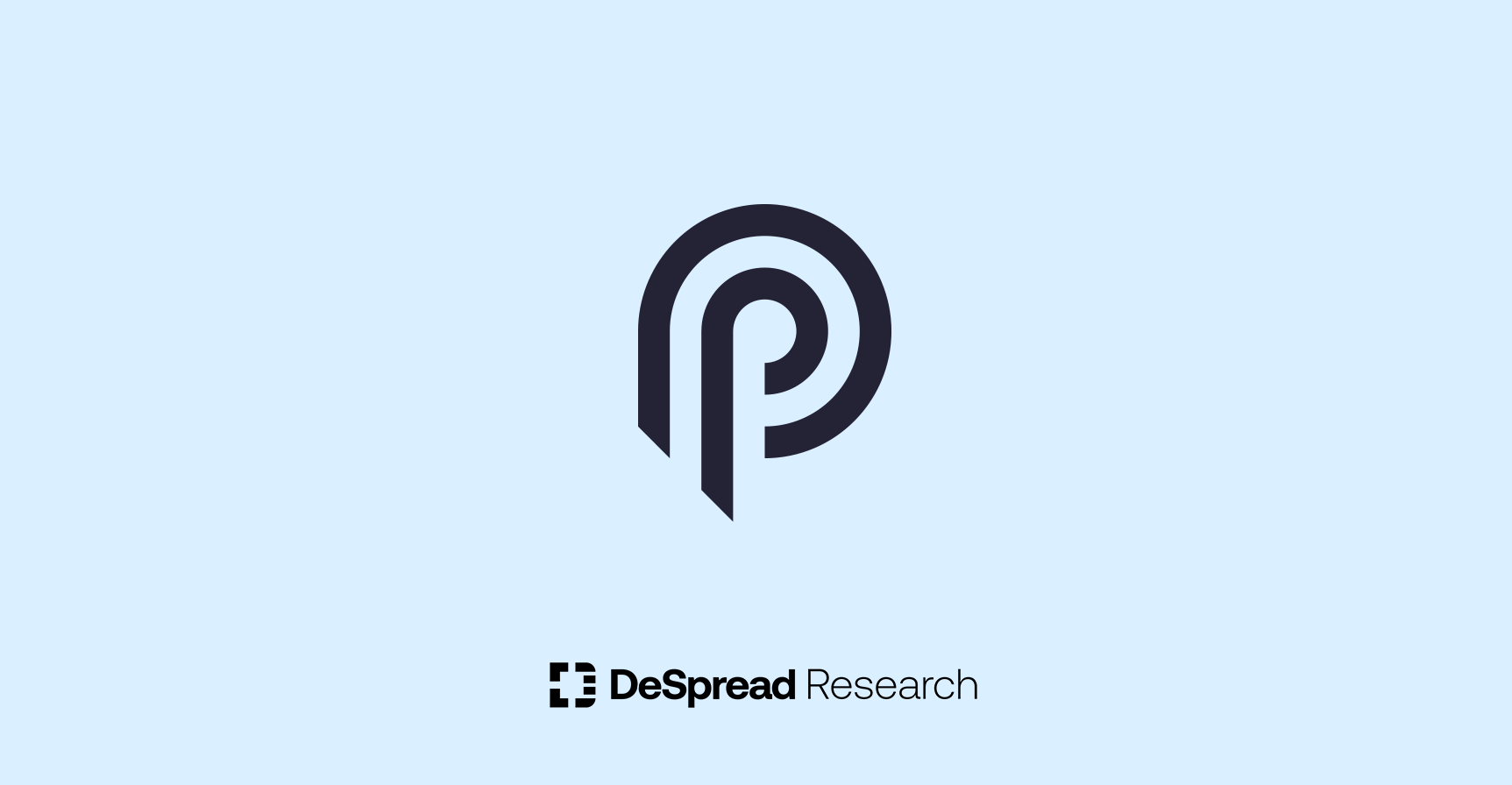
Pyth Network — A New Oracle Tries Everything to Make Foray into the Market
A New Oracle Tries Everything to Make Foray into the Market

Preface
What is Oracle?
Oracle is a system that fetches input values used in smart contracts from inside and outside the blockchain.
Previously, the definition of Oracle was confined to fetching data from the real world outside the blockchain. These days, there are increasing cases where data is provided from on-chain protocols such as Uniswap, and the scope of Oracles has expanded to include both on and off the blockchain.
Any protocol that desires to create a service using a smart contract must have input data for the smart contract. In such a case, the said protocol should either self-supply the data or receive it from other parties.
For instance, when AAVE, a leading decentralized money market protocol, wants to provide $ETH-backed $USDC loan, AAVE needs to accurately identify the value of the said collateral and the asset to be provided as a loan in real-time. This is because wrong identification of an asset value causes lending that is larger than the actual value or no proper liquidation made even though the value of the collateral asset becomes lower than the loan asset value, which leads to a direct loss on the protocol side. Moreover, improper liquidation may occur even if the value of the collateral asset is enough to cover the loan asset, which can seriously damage a user.
The lending protocol lacks a mechanism that enables the protocol itself to find price data for various assets. Therefore, the protocol must fetch the most reliable price data from somewhere else. Centralized exchanges have more liquidity, transactions, and faster data renewal interval, the components for which the retrieved data is considered reliable. To establish a system for supplying and renewing data, protocols should either build an oracle themselves or leverage projects specialized in data feeds. Some protocols do both to prevent a tail risk.
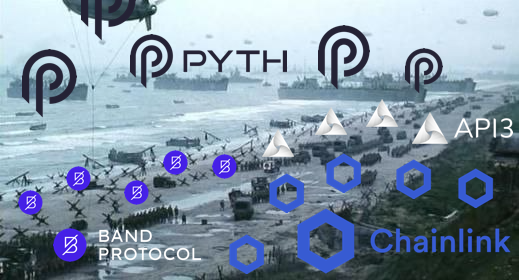
This report introduces and analyzes a specialized oracle service provider, Pyth Network. The most familiar oracle project is Chainlink, which stood together with the Ethereum chain from the inception of the DeFi industry and has been exclusively providing data around EVM chains for a long time. Pyth Network, on the other hand, is a latecomer in the oracle market, having launched its mainnet on Solana chain in August 2021. At that time, Chainlink did not provide oracle services to the Solana chain, making it relatively easy for Pyth Network to bootstrap centered around the Solana ecosystem in the initial stage. However, Pyth Network is now in full swing to enter into EVM chains and Ethereum. Starting from BNB Chain, Pyth was also prompt to contact a newly emerged Aptos chain, to deploy Pyth contract on their mainnets, expanding at an incredible pace to acquire a significant share of the Oracle market.
- Growth Trend in the number of DApps using Pyth price feed.
- Giant Multinational Institutions as Data Providers; Chicago Board Options Exchange (CBOE), Binance Oracle, QCP Capital, Jump Trading, etc.
Let’s take a look at how Pyth Network Oracle is different from Chainlink, what makes it special to be able to confidently jump into the multichain oracle market as a latecomer.
Table of contents
- Pyth Network Team
- Products
- Operation Mechanism
- Business Model & Token Economy
- Competitive Landscape
- Risk
- Roadmap
- Summary
1. Pyth Network Team
Pyth Network is being built around a supporter called Pyth Data Association, whose director is Mike Cahill (Twitter).
Mike Cahill started his career in FX sales at Morgan Stanley in 2006 and his 13-year experience in the traditional financial services industry includes working for Nomura Securities and Cboe Global Markets (CBOE). Now he has been working in Jump Crypto since he joined in 2019. In addition, he has been working as a director of the Pyth Data Association since 2021.
Dave Olsen, the president and CIO of Jump Trading, was the first to announce the inception of Pyth Network on April 7, 2021, and Kanav Kariya, who is now president of Jump Crypto, has been mentioning Pyth Network in the media and on Twitter.
Therefore, one can guess that Jump Crypto is backing up the building, which the director of Jump Crypto leads. Other disclosed Pyth Network Contributors who belong to the Jump Group include Saeed Badreg, Jayant Krishnamurthy, Stephen Kaminsky, Ray Song, etc. In addition, the information of Pyth Data Association team members who are not part of the Jump Group can be found in the link.

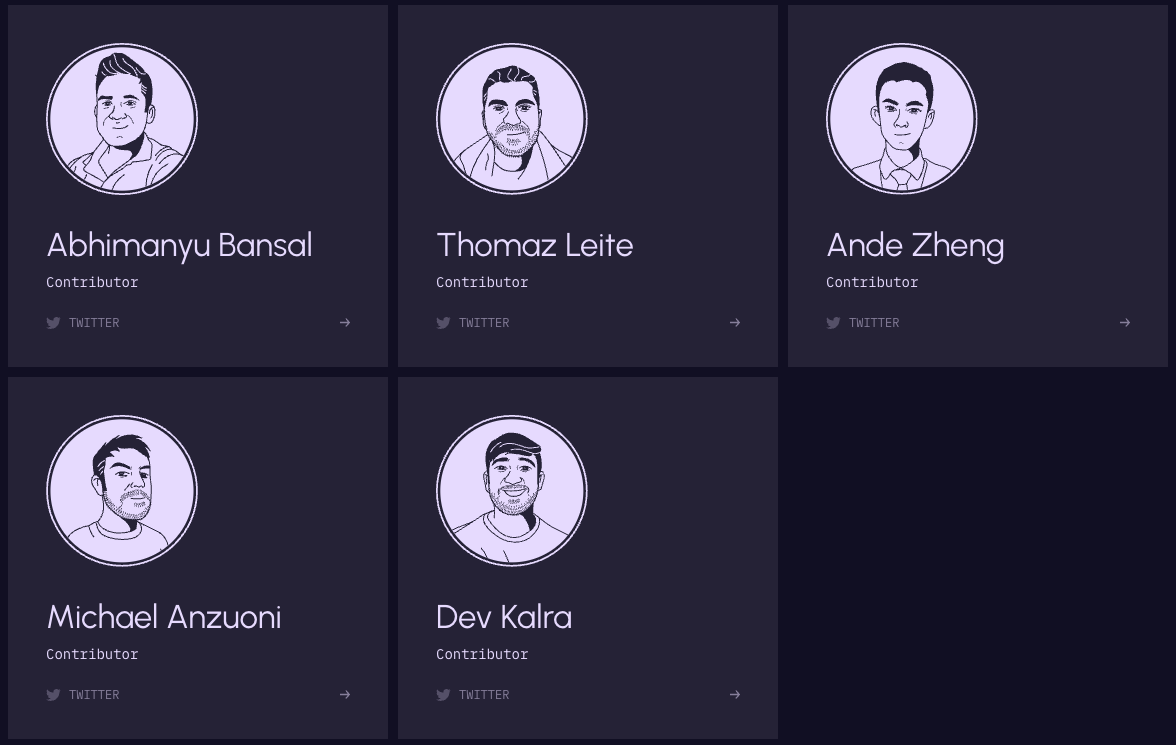
2. Products
Pyth Network is an oracle specializing in price data in the financial market. Therefore, its product offerings are price data of digital assets in the crypto market and traditional financial assets such as stocks, FX, and commodities. Wrong price data and delay in information update may lead to significant monetary loss, so the data quality and the update speed are most prioritized.
2.1. Data update speed
Data provision and aggregation of Pyth Network takes place on the Solana chain or Pythnet. Therefore, the feed proposed by Pyth Network is able to be updated at the speed of Solana block creation, which is less than 1 second. Of course, using Pyth Data feed on other chains may limit the update speed not to exceeding that of block creation in the said chain. However, it remains unchanged that the updated data is fresh data renewed at a breakneck speed.

2.2. Data quality
The data publisher of Pyth Network creates from the price finding mechanisms (orderbook, AMM, proprietary trading, etc.) by itself, which is the real data owner and directly supplies the data to Pyth Network. Furthermore, who is onboarded on Pyth Network as a data publisher is directly related to the data feed quality. Pyth Network, after the launch of the mainnet, has secured more than 70 direct data publishers for about one year, and the list includes mega-sized institutional exchanges and proprietary trading firms.
The structure where the data publisher is directly responsible for the data provision differs from the existing oracle model. Pyth Network calls this model the Publisher Network, and distinguishes it from the traditional model, called the Reporter Network.
A reporter network is not an owner that produces data, but it is a network consisting of node operators that fetch data from the data aggregators such as CoinGecko and report data as a third party. From a perspective of a single point of failure, Report Network may be more stable. However, regarding data quality, Publisher Network will be much better.
Like other oracles, all data publishers of Pyth Network should deposit governance tokens collaterals. Also, in the case of wrong data provision or non-provision, the publisher should be responsible for its own data and take the risk of collateral token slash. Therefore, Pyth Network, due to the publisher network attribute, will feel confident that it owns quality data and will benefit from the system where publishers who have the ability to provide data on time will be selected and remain.
Of course, now is a stage before the token issuance that no decentralized governance is taking place, and the Pyth development team is leading the onboarding of data publishers. Regarding this, how DAO’s decision-making can discern quality data publisher after it becomes a DAO will serve as one variable.
2.3. Confidence Interval
As part of an effort to ensure data quality, Pyth Network is the only oracle that provides the confidence interval for the price data. For instance, the price of $BTC is provided in a format of $20000 ± 40.
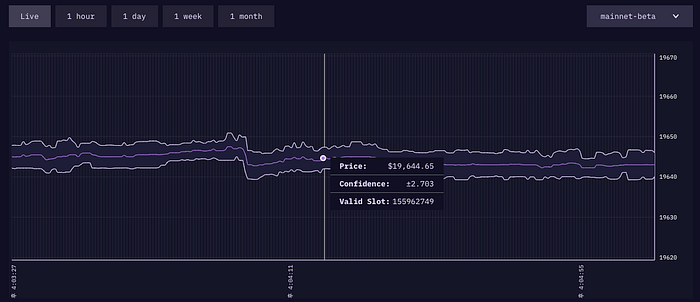
The data provided by order book-based exchanges such as Binance is a mid-price of the best limit bid price for buy and sell, which makes it inevitable to have a discrepancy from the actual price. Also, each exchange would have an order book with different statuses, and each proposes different prices.
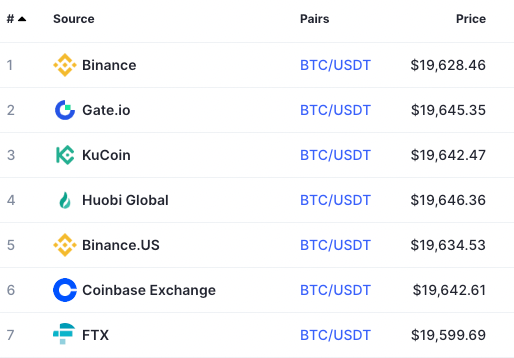
What’s more, in the case of data provided by the market maker that concludes an actual deal, the asset price data is identified based on the actual deal price, which makes it inevitable to have a difference from a price based on the best bid-price provided by the exchange. Pyth Network aggregates all different numbers of cases and offers price data and confidence interval. Therefore, the protocol that receives the data from Pyth Network can utilize the confidence interval and operate a smart contract with more precise criteria.
For instance, a lending protocol that receives price data and the confidence interval evaluates the value of the collateral asset and sets the asset price criteria to assess whether it conforms to the liquidation criteria along with the confidence interval. Therefore it can make a choice that prevents the wrong liquidation caused by market price disruption.
As shown above, Pyth Network prioritizes data quality and update speed and currently only deals with the data for financial assets. In contrast, it is also an oracle for niche markets by specializing in financial asset price data provision.
On the contrary, Chainlink, a representative protocol for oracle, as the existing dominant player, is not confined to the provision of financial asset price data but deals with data of a larger range. For instance, it aims to connect all data including sports betting, geopolitical news, weather forecast, etc., to the actual world outside the blockchain.
3. Operation mechanism
There are many differences between Pyth Network Oracle and other Oracles regarding the operating mechanism and design structure. Therefore, we will discuss in detail from the fundamental operating mechanism to the Pyth-specific network design characteristics.
3.1. Data delivery process
Pyth Network supplies data to the final destination in the following sequence.
(1) Data publisher transmits the data they collect (owns) to the On-Chain program of Pyth Network
(2) Pyth On-chain Program aggregates the price data and confidence interval transmitted from the multiple data publishers and post data feed on the platform
(3) Data update as data consumer requests feed to the Pyth On-Chain program (On-Demand model)
That is, Pyth Network can be said to be a data marketplace that only aggregates and posts the publisher data, and the consumer visits the said marketplace and takes the data they like.
3.2. Participants
Players participating in the marketplace of Pyth Network are classified into three types as followings.
(1) Publisher: The publisher provides data he owns and earns the fees paid by the consumer. The more data, the higher the fees. $PYTH should be taken as collateral to provide data, and wrong data provision exposes the publisher to the risk of slashing.
(2) Consumer: Data purchaser that wants to receive price feed. Pyth Network does not limit purchasers to on-chain DApp and provides data to off-chain applications. What is unique is that the data feed of the Pyth Network itself is free to use, and the user may choose to pay the fees for the insurance to protect against wrong oracle updates. Also, those who paid fees can claim the amount for slashing the publisher and delegator for the inaccurate data provided. Therefore, the insurance fees are the source of revenues for the publisher and the protocol.
(3) Delegator: A $PYTH holder stakes the token to a specific data feed and data publisher and takes a part of the data profits (variable by the governance after the initial setup 80%). And, the feed of a publisher who secured large staking from the delegator within a specific data feed gets to take a larger proportion in the data aggregation mechanism in Pyth On-Chain Program. Also, in the case wrong data is provided to the consumer, the delegator is jointly liable and exposed to the slashing risk.
Therefore, there will be a power game between staking to a publisher who secured confidence from many people through a large delegation and securing a higher stake by staking to a publisher with less delegation. As a result, if there are more token holders and the active staking is, the amount of delegation will efficiently represent the publisher’s trust level and will come to a structure where a delegator plays an important role in effectively protecting the data platform itself.

3.3. Slashing & Insurance System
Even though a publisher is responsible for data provision and the delegator guarantees the publisher’s confidence level, suppose the difference between the price and confidence level of the data provided to the consumer and the measured data is confirmed. In that case, the collateral of the publisher and delegator will be slashed. Insurance benefit is paid to the consumer (only those who paid the fees in exchange for insurance benefits).
Anyone can report data errors and claim insurance benefits under a no-permission principle. Also, the assessment of errors in the data provided is done in a fair manner by an algorithm previously designed in reference to the off-chain measured data based on HUMAN protocol’s on-chain dispute resolution service. However, the final “approval” is determined via voting of $PYTH token holders. It has a token holder to filter out indiscriminate insurance benefit claims and algorithm errors; whether a token holder will give proper approval as to what turns out to be an actual error is the question. It is because deciding on approval leads to a result that works against the benefit of the $PYTH token holder. However, even though there is clear evidence that the data provided is wrong as a result of algorithm results and no approval is given, the consumer will not join the insurance, and the fees that go to the token holder won’t be there anymore, which will lead to a larger loss in the long term.
It is not certain whether multiple token holders can create a proper decision-making system to ensure mutual long-term benefits from the said mechanism. One alternative is a governance-elected council. On October 14, 2022, Pyth Network announced that it would build a council system where a community elects the decision-making representative of DAO using the Squads Protocol.
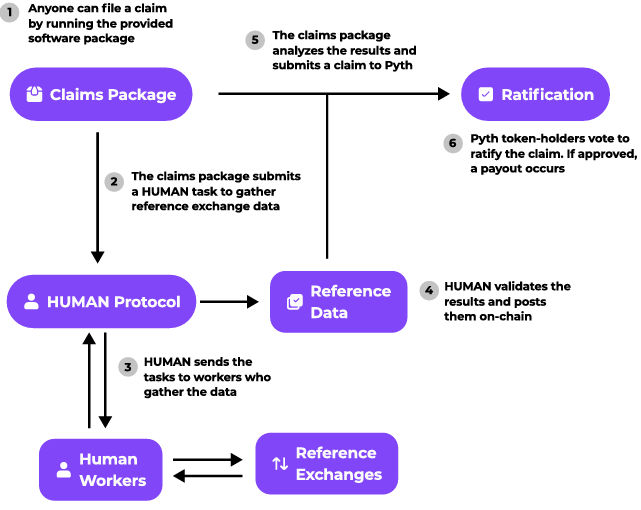
Looking at how Pyth Network operates so far, one can know that there is no single centralized entity that determines all parameters, but three types of network participants make a decision for their benefit to get the data marketplace going. Pyth Network provides only the infra for the said marketplace and earns parts of the fees generated on the platform. It is a structure where larger economies of scale against the data demand-supply industry can promote more effective growth.
Important note: The role of each network member and a model about slashing & insurance benefits are written under the premise that a governance token was issued. As of October 2022, Pyth Network has yet to issue tokens, and the model was planned at the time of the mainnet launch (August 2021), and changes may occur after the actual token adoption.
3.4. Other Features
(1) Publisher network
The advantage of the publisher network is that it has a cost-effective structure in addition to the data mentioned above quality. The system is middlemen tax-free, and the data producer and consumer make a direct transaction, which provides profit/cost best for both parties.
(2) On-chain data aggregation process
Another noticeable characteristic is that data aggregation is done in an open manner On-chain. Therefore, one can have a transparent view of how data from the numerous data publishers are aggregated and which publisher is accountable for when there is an error in data.
(3) On-Demand, On-Chain Data update model
There are two significant points to consider when building a model where an oracle collects data and delivers it to consumers.
- On-Demand vs Push
An on-demand model provides data upon data consumers request, and a push model is mandated to update data regularly under certain rules. Pyth Network is an on-demand model as it updates data in response to a consumer’s request.
The push model delivers aggregated data to the data consumer based on predetermined criteria such as price fluctuation and time passage.
- Off-Chain aggregation and On-Chain delivery vs. On-Chain aggregation and Delivery
Pyth Network receives data via Pyth Onchain program from the data publishers and aggregates the data, and discloses it on the Pyth data marketplace all the time. And it transmits the said aggregated data in response to the consumer request.

Let’s look at the example of the On-Chain aggregation and On-demand delivery model adopted by Pyth Network and its opposite Off-chain aggregation & push model.
Consumers of off-chain aggregation & push model data must update the data aggregated off-chain by the specified price variation and time passage criteria. Also, if a consumer must spend a gas fee to be provided with the data aggregated offline to on-chain, it is not only gas inefficient, but also the speed at which data is updated is very limited.
In fact, one of the reasons why it is difficult to aggressively expand the assets that are targets of financial services provided by a lending protocol like AAVE and Compound is the cost related to the said data update. After paying for the data and gas fee, it is not profitable to receive off-chain data by taking a collateral risk against a long-tail asset that does not create revenue as there is no active borrow & lending. In contrast, it is confirmed that Euler Finance, regarding the long-tail asset price update, uses the Uniswap Oracle as it already exists on-chain and saves data costs and gas fees, thereby onboarding many assets.
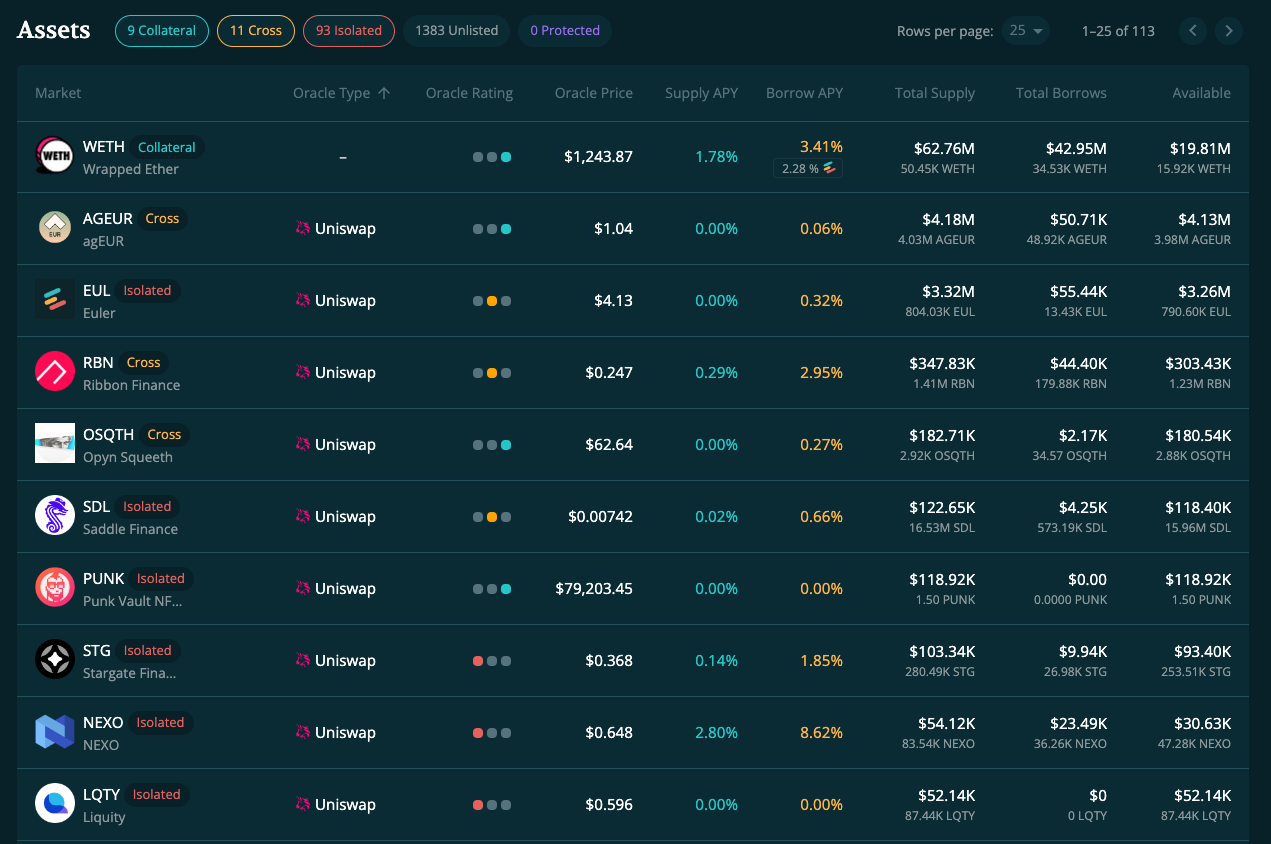
As Pyth Network also performs data aggregation on-chain, the data to be delivered to consumers exists on-chain, and consumers can use the on-chain data as it is. That is, the gas fee for sending Off-Chain data to the On-Chain is paid by the data publisher, and it is from the Solana chain / Pythnet, so the gas fee is minor.
Also, the data update by Pythnet is performed upon the consumer’s request, so there is no need for the update if there is no request. Therefore, data update via Pyth Network is very gas-efficient, and the said model can be said to be ammunition that can increase market share in a consumer-friendly manner.
(4) Multichain expansion using Wormhole cross-chain messaging
Pyth Network collects data on-chain from publishers and utilizes the fast speed and low gas fees that are Solana-specific until the aggregation is completed. On the contrary, as it uses the Solana based blockchain, it is the only protocol that can quickly implement a consumer-friendly model that can make publishers to pay for the gas fees and on-chain data aggregation mechanism.
To expand the consumers for the data marketplace built this way and fully utilized economies of scale, it needs to expand into other blockchains beyond the Solana ecosystem. Therefore, Pyth Network uses Wormhole’s cross-chain messaging function to provide Pyth data feed to other chains. The Wormhole performs attestation of Pyth price and relays the data to Pyth contract built on other chains.
Also, a problem may occur in the Solana blockchain itself; the aggregation of data feed for transmission to other chains is separately done on a network called Pythnet that uses the Solana code base as it is.
By leveraging Pythnet and Wormhole, theoretically, one can secure Pyth data feed consumers against all chains that Wormhole supports. Currently, the BNB chain and Aptos are where Pyth Network has entered, and there are also Ethereum and other EVM chains that show the Pyth Network is in full throttle for higher market share.
3.5. Chainlink
To help you better understand the design characteristics of Pyth Network mentioned so far, let me compare it with Chainlink, a leading protocol for oracle at the moment.
In the case of Chainlink, it is a decentralized network through node operators, which is the most familiar model. The node operators consist of DevOps teams such as 01node, Artifactstaking, Inotel, Kaiko, and Huobi. These operators collect data from the aggregators (CoinGecko, CoinMarketCap, etc.) that own data whose aggregation is already completed and report the medium values. And the medium values submitted by each node are aggregated to form a single data feed.
Chainlink also used the delivery after the on-chain aggregation model during the initial stage. However, as it dominated the Ethereum chain, it needed another gas-efficient model. It is because aggregating data on-chain after sending each of those various data on-chain incurs huge gas fees.
Therefore, a new model proposed in early 2021 is the off-chain reporting model. When aggregating data offchain, a single onchain transmission saves gas fees. Therefore, after the advent of the said model, the OCR model is currently the main one in use.

Chainlink is a Push model. Therefore, Chainlink data consumers receive data updates in accordance with the following two conditions.
- Price Condition (Deviation Threshold): Price is automatically updated when the price fluctuates x%.
- Time Condition (Hearbeat): Price is automatically updated when the time passes x minutes.
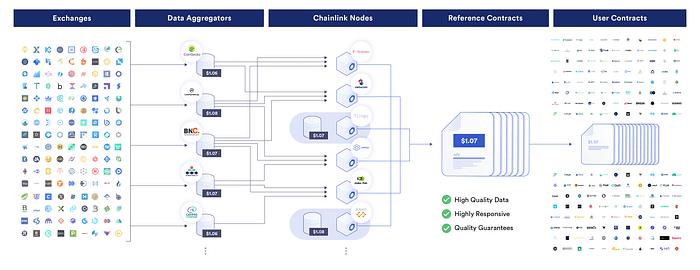
An easier explanation is that the entity on the leftist above Figure 12 that creates the rawest data is the data publisher and is responsible for the node as well in Pyth Network. Later, the Pyth On-chain program aggregates data and posts on the marketplace. Therefore, Chainlink can be called a reporter network in which node operators, who receive data from third parties, accurately aggregate and report the data, while the Pyth Network is called a publisher network because the data originator itself is responsible for the quality of the data and directly contacts the market place to supply it.
Chainlink, as announced in economics 2.0, demands $LINK as collateral to the node operator and therefore takes the risk of slashing when delivering a wrong oracle. The structure of the delegator and staking system is similar to that of Pyth Network, but in Chainlink, there is no relation between the staked amount and the portion used for price aggregation and uses the medium value of the data reported by the node. Therefore, the difference is that delegator’s staking impacts the Pyth data feed, but the Chainlink data itself is irrelevant to the staking.
In the event of wrong data delivery of Chainlink, the mechanism that reports the slashing structure and the said event is done in the form of internal whistleblowing, which is frequently used in PoS. Therefore, $LINK pool that was created from the slashing goes to the whistleblower. The remaining parts are used to compensate stakers who were affected by the slashing. That is, the Chainlink slashing is used to compensate not the consumer but the publisher, and most prioritize the stable supply system. Therefore, it does not require an insurance claim process for the data consumers.

Unlike Pyth Network, one must pay fees to consume data, and it is a Push model, and the gas fees to receive updated off-chain data should be paid by a consumer. It is a feature unique and noticeable to Chainlink, where the bargaining power of suppliers is based on the infra verified for a long time.
On the other hand, Pyth Network:
(1) Demands fees only to data consumers that want to join insurance to protect against wrong data.
(2) It uses slashing as the said insurance benefits.
(3) It is an on-demand model that provides data only when a consumer wants it.
(4) Aggregates and transmits data on-chain, so the off-chain to on-chain gas fees are paid not by the consumer but by a publisher.
All these, contrary to Chainlink and Pyth Network, can be said to focus on providing consumer benefits.
Lastly, unlike Pyth Network, which aggregate data from an on-chain (Pythnet) and supplies it to another chain through Wormhole, Chainlink consolidates data off-chains and directly feeds data to each native chain. Therefore, Chainlink does not rely on a third-party relayer and is free from the risk created by external factors.
4. Business Model and Token Economy
4.1. Revenue structure
The revenue streams into Pyth Network rely on the insurance premium that data consumers want to pay to protect against the wrong Oracle data provision. Unlike the existing Oracle protocol model, it does not require fees for all data users, meaning it might have a weak base to create revenue. However, meeting the following conditions could make the Pyth Model the optimal strategy as a latecomer oracle protocol.
Variables influencing Pyth Network’s revenue are largely divided into the following two.
(1) Market penetration
Pyth Network, compared with other oracle protocols, has built a consumer-friendly system and will be able to secure a market share at an exponential rate. Also, Pyth data feed, in theory, can use the cross-chain messaging system to provide data to all blockchains, meaning all applications on the blockchain are potential clients. Therefore, the force to expand into the cross across all ranges and market penetration rate through a consumer-friendly model will be the first critical point, and whether it is possible to expand the economies of scale will be determined here.
The following timeline currently provides a preview of Pyth Network’s market penetration ability.
- October 4, 2022: Expanded the chain, starting with the BNB chain and including Binance oracle as a data publisher, thereby establishing an advantageous position for BEP token to capture BEP token market share, which shows its seasoned ability to expand the business.
- October 19, 2022: Each DApp started to connect to the Aptos mainnet, and Pyth Contract took its position and secured ten or more data consumers faster than any other oracles. This initial dominance was possible as the delivery of Oracle infra that was already completed in Pyth Network was done via Wormhole.
- November 2, 2022: Penetrated into Ethereum and Optimism chains and secured significant DeFi protocols such as Synthetics, Ribbon Finance, Lido Finance, Hash Flow, Euler Finance, etc., as data consumers
The above shows the ability of Pyth Oracles’ market penetration that strongly pushes forward.
Therefore, in the future, (1) incorporating many existing DApps as new consumers, (2) quickly connecting to a newly emerging chain, and continuing to demonstrate its ability to capture data consumer pool early will be the way to success for Pyth Network.
(2) Oracle insurance use rate
Even though the market share rate in the overall blockchain has increased, when Pyth price feed is used as free public goods, it cannot create revenues. The demand for insurance fees to protect against the wrong oracle, which is an option, is critical.
Of course, currently, where there is no token issuance, the slashing/staking/insurance functions are not activated, so it is uncertain whether the structure where insurance will be a revenue stream would work smoothly. Insurance benefits claim process through HUMAN protocol and token holders’ making a proper final approval should be done for sure, and keen attention to the actual demand for insurance should be paid.
However, considering that it provides Oracle specialized in financial asset price data provision, a large share of Pyth Network’s customers will be taken by DeFi protocol, such as a lending protocol. There is a significant risk regarding a wrong Oracle, meaning it is easy to guess that there will be enough demand for insurance to hedge risk.
Fortunately, the current planned revenue structure can be changed in the future. For instance, when the Network thinks it needs to increase the margin rate, it can be changed into a model that charges user fees to the consumers.
4.2. Cost structure and tokenomics
Pyth Network is a marketplace that matches data publisher and consumer, so the direct costs coming from the said service are limited to the costs of network maintenance and expansion. Also, the on-chain data aggregation performed by the Pyth Onchain program takes place on the Solana chain or Pythnet, so the gas fees are very cheap.
However, in reality, costs to issue and provide tokens as incentives for Network bootstrapping and expansion will be incurred, and the token economy that will be expensed as the said costs is publicly disclosed.

Costs that are incurred from the Network bootstrapping and expansion are as follows.
(1) On-Chain Rewards (22%)
These are costs to be used for bootstrapping for price feed that will be added to Pyth Network. When it comes to expanding a new price feed, there is no existing data consumer, so an incentive that will encourage data publishers to adopt a new price feed is required. Pyth Network allocates 22% of the token volume and uses them to cover costs for publishers, and 8% of them can be used at any time right after the token issuance, and the remaining 14% is planned to be used over the next seven years.
(2) Ecosystem Participation (33%)
There is no official statement regarding the said allocation utilization. The costs required for token launch and the full-swing market penetration in the future will be covered from this item, and it can be viewed as a reserve of Pyth Network, which can be changed flexibly upon circumstances.
On the contrary, the said costs can be a variable, and as it accounts for 33% which is quite a large portion. What is recommended is that either less cost be incurred from a token holder’s perspective, or the costs are used as a staking compensation, at least to bootstrap a delegator.
The other Team & Advisors (25%) and Launch Partners (10%) are estimated to be for human labor and incentives and token launch, respectively. These are items whose costs accrual is confirmed.
4.3 Value Accrual
Under the currently planned model, a token holder delegates a token to a data publisher and receives 80% of what the data consumer pays (insurance premium). The allocated amount and the fee payment token can be changed via governance.
As market share increases, the more consumers, the higher the profitability. Therefore, one can pull demands for supply from the data consumers and create a demand for tokens that will be used as collateral. Furthermore, a data publisher can delegate the token they own in an amount that is more than what is required as collateral to increase his share of the data supply, which can create additional demand for tokens.
However, those two mentioned above are achievable under the condition that the fees from the data consumer will be enough. Therefore, the protocol should appeal to the benefits of insurance for Oracle to consumers and simultaneously enter various blockchains to secure sufficient market share. As the said condition is met and, therefore, the token demand to be locked up and the fee allocation are more substantial than the number of tokens to be issued to cover the business expansion costs, a token holder will be able to accrue values successfully.
5. Pyth Network Competitor landscape
5.1. Chainlink
Chainlink is a long-time leader in oracle market share and owns TVS that amounts to $20B, more than 1000 node operators, 677 price feeds, and more than 890 on-chain/off-chain data consumers as of September 2022. As a proven oracle network, the system operates around publishers and stakers based on the bargaining power of a publisher.
The followings are related features.
- Data consumers’ adoption of Chainlink oracle needs to go through an off-chain process that takes time, and it is not a permissionless system.
- A consumer pays the gas fees required to fetch data from offline to on-chain.
- Data is not for free, and fee payment is not optional.
- Slashing caused by wrong data provision goes to publishers and stakers, not consumers.
- Therefore, the margin that the protocol and publishers get is high.
Chains covered by Chainlink are as below.

The list includes Ethereum, Polygon, BNB chain, Abitrum, Avalance, Optimism, Moon River, Echo, Fantom, and Metis. It seems that it secured market share largely around EVM chains. In addition, in June of 2022, it entered the Solana chain and provided data to around 70 protocols.

As of October 2022, Chainlink provides up to 667 data feeds. It is a move to incorporate unique data, such as sports betting and weather feeds, not confined to the asset price data.
Furthermore, based on the long development period, it engages with not only data provision services. Also, business in various areas, including VRF, smart contract automation, cross-chain messaging (CCIP), proof of reserve, etc., will receive relatively high valuation even though it owns the same TVS as an oracle network.

5.2. Band protocol
Like Chainlink, it is a reporter network where a decentralized network consisting of node operators relays data as a third party.
Band Protocol is the only oracle network that has its own blockchain (Band Chain), and as the data aggregation takes place on a band chain, it has an on-chain aggregation process. The node needs to stake tokens as collaterals, and it has a system where a third-party token holder delegates. However, wrong price transmission is not subject to slashing, non-transmission is subject to slashing, and the penalty goes to the protocol treasury, which is another attribute unique to the protocol.
The data provision is done on-demand upon the consumer’s request. It is a permissionless system; anyone can send a request, and the data usage fee incurs upon the request cases.
Band Protocol’s product offering is a financial asset price feed, including digital assets, FX, commodities, etc. The main targets are Ethereum and some EVM chains, and it recently started VRF service, which is an attempt to challenge Chainlink’s market share.
Band protocol provides 195 data feeds as of October 2022 and owns 72 node operators and 28 data consumer networks.
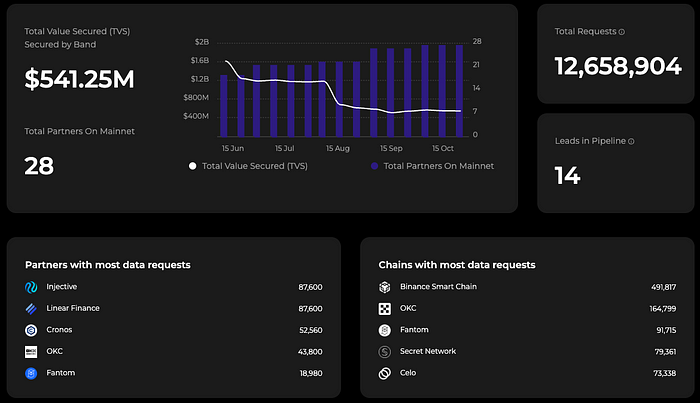
5.3. API3
The motto of API3 is to realize decentralized API, a publisher network where a data publisher directly provides data on-chain. Therefore, it is neither Chainlink nor Band Protocol, but an oracle network that is like Pyth Network. However, there is a major difference that in API3, not the data publisher but the data consumer pays for the gas fees when fetching the data to on chain.
API3 directly receives data on blockchain where a consumer has a hub, so it does not need any intermediaries protocol to transmit data multichain. Therefore, a gas fee of the native chain to fetch data from off-chain to on-chain needs to be paid by the consumer. The said gas fees may burden consumers depending on the chain, which is a publisher-friendly network.
The insurance that protects against the wrong oracle cooperates with Kleros, an on-chain dispute resolution protocol. The insurance fee incurred apart from the data usage fee and the insurance benefit approved is withdrawn from the insurance premium staking pool that directly received funding from the governance group that consists of API3 DAO. Therefore, it has a feature that the governance will be formed in a way where multiple stakeholders maximize security.
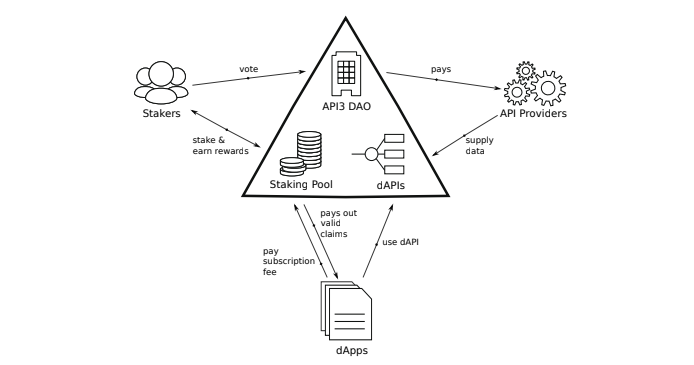
The number of data publishers participating in the Network is 169, and the number of data feeds provided is 18. The chains supported include Avalanche, BNB chain, and Polygon. TVS and the information regarding data consumer are not disclosed yet.
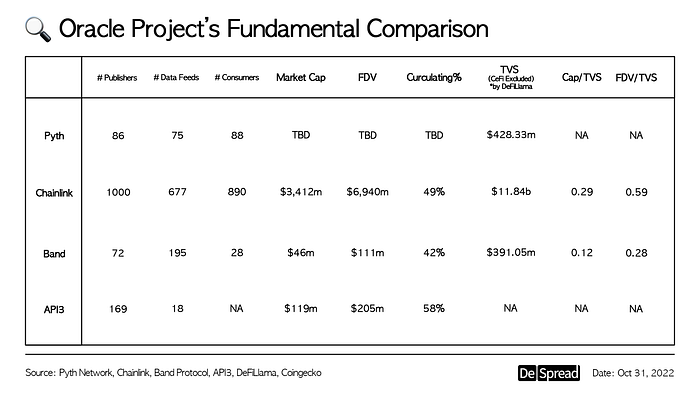

6. Risk
6.1. Publisher onboarding risk
The mechanism to select data publishers to be onboarded on the Pyth Data marketplace in the future will be done through decentralized governance. What is critical about Pyth Network is that it provides high-quality data directly provided by data procedure on time, and the advantage of the marketplace model itself will be lost if there is a wrong onboarding of the data publisher.
Until now, Pyth Network, under the lead of Jump Crypto, has secured more than 80 proven data publishers, including giant multinational exchanges and trading firms such as CBOE, Binance oracle, QCP Capital, Jump Trading, WinterMute, etc. As such, Pyth Network will have to perform Dao conversion after the core contributor onboards sufficient data publishers first, and it will have to pay attention to the assembly system model where the community elects a DAO decision-making representative, which it is currently planning.
6.2. Insurance claim process risk
To collect insurance premiums from more consumers, as the premiums are the only source of revenue for Pyth Network, it needs to secure an advantage and confidence in the insurance. Suppose the community does not accept the short-term costs and therefore does not properly approve the insurance claim decision made by HUMAN protocol. In that case, no one will pay an insurance premium to Pyth Network.
6.3. Advantage from the data quality and contradiction from the insurance payment.
In contrast to pitching good quality financial asset price data and confidence interval, the revenue stream depends on an insurance premium in case of wrong oracle. Therefore these two elements can conflict and disrupt protocol revenue.
Even though it is a protocol vulnerable to oracle risk and receives demands from the target customer base for the high level of confidence in the asset price data, the protocol has to provide enough information to consumers on how beneficial the risk transfer through insurance would be.
6.4. Wormhole Risk
Data sourcing and aggregation of Pyth Network all take place on the Solana, which provides speed and efficient gas fees. Similarly, the data for other chains that enter to expand business are aggregated on Pythnet which is a separate network based on the Solana code base, and to relay this to the applicable chain, one requires a third party’s relayer such as Wormhole cross chain messaging. Therefore, there is a possibility that an external risk factor that is uncontrollable by Pyth Network may be generated from Wormhole.
Of course, combining Wormhole is also an advantage. Pyth data feed can penetrate easily into all chains supported by Wormhole. Thanks to Wormhole, the oracle was connected to the newly emerged Aptos Chain recently and therefore secured data consumers during the early stage.
6.5. Market penetration risk
At the time of the Pyth Network launch, there was no leader in the Solana Chain who dominated the oracle market, so it was a land of opportunity for Pyth Network.
However, in chains other than Solana, including Ethereum, which it needs to penetrate later, the markets are already dominated by existing oracle for a long time. Therefore, despite the excellence of the Pyth Network model, there is a possibility that it won’t be selected by the oracle market. The Pyth Network’s consumer-friendly business model is advantageous in capturing a market share. However, if it fails to be adopted by consumers of the said chain after the business expansion, the margin could drop steeply. In this regard, achieving economies of scale will be highly critical.
However, there is no such rule that protocols should rely on one oracle. In particular, a protocol that utilizes financial assets can strengthen its level of protocol protection by adopting multiple oracles and giving weights. The protocol will have to pinpoint the relevant demand so that the consumer-friendly business model can be broadly penetrated.
Pyth Network started its penetration from October of 2022 and now entered the BNB chain, and did not miss Aptos, a land of a new opportunity. It seems to be in full swing to penetrate into the Ethereum chain recently, and until it enters DAO, the role of a core contributor led by Jump Crypto will be very critical.
7. Pyth Network Roadmap
7.1. Consumer network (chain) expansion
Pyth Network has already secured almost 90% market share by TVS on the Solana chain. Starting with its entry into a testnet of the BNB chain in May 2022, it has been expediting its efforts to enter into other chains since October of the same year. It is capturing data from consumer networks on Ethereum and Optimism chains in addition to BNB Chain and Aptos’ Mainnet. As Wormhole is already adopted as a relayer, it is not difficult to expand the Network by setting up Pyth Contract on other chains supported by Wormhole. Therefore, Pyth Network, while targeting the EVM Chain, a loser of the existing crypto market, moves forward with its strategy to have a firm grip on a new emerging chain.
7.2. Publisher network expansion
Pyth Network is expanding the publisher network, led by a core contributor. Not only the publisher’s qualitative aspect (data reliability and on-time supply ability) but also the quantitative aspect are important to keep the Pyth marketplace robust. Therefore, the publisher network expansion, without any comments, will stand to be an ongoing roadmap going forward.
7.3. Token utility adoption
Now data marketplace of Pyth Network is being run without the token issuance. Therefore, the publisher is providing data for free, and the consumer is receiving data for free, meaning that the model of marketplace expansion through the decision-making by the Pyth Network’s much proud three types of network participants who act for their own benefits is not realized yet.
On the contrary, token adoption enables data publishers to receive incentives, broadly expanding the publisher network. Along with the token holder’s staking model, Pyth Data Marketplace will become very robust. Accordingly, the Pyth Data Feed will be a more attractive product. As a result, one can expect a roadmap where a revenue structure becomes stabilized as the consumer network expands.
7.4. Token governance adoption and becoming DAO
At present, Pyth Data Association and Jump Group are leading the expansion of Pyth Network as core contributors. It plans to move to a decentralized data marketplace via token governance later when the Network is stabilized. It considers adopting a council system where a community elects through governance for more efficient decentralized decision-making.
8. Summary
Pyth Network launched its mainnet in August of 2021 and is a latecomer in the oracle market, achieving drastic growth by dominating the Solana chain where there was no loser of the oracle market. Pyth data feed is concentrated on the financial asset price data for which quality element is the most important. It specializes in such products and targets a niche market to capture a market share. Regarding data quality, it differentiates itself by providing data through a publisher network that receives data on time directly from selected data owners and by providing the confidence interval for the price data together.
It has taken a business model that is consumer friendly compared with other oracles, which is more advantageous to secure a market share. However, if it fails to achieve economies of scale, its profit margin against the cost of market expansion will drop drastically. Therefore, Pyth Network is in full throttle to enter the oracle market of other blockchains in addition to Solana and has so far entered Ethereum and other EVM chains after it entered into the BNB chain in October of 2022. Also, it successfully preoccupied consumers by connecting Pyth Oracle the fastest as soon as DApp was activated on the mainnet of Aptos Chain.
Competitor protocols include Chainlink, Band Protocol, and API3, dominating the EVM chain, which is mostly populated with consumers that utilize financial asset data. For Pyth Network, the possibility of effectively penetrating into the EVM Chain will be critical for its future growth. The competence of the core contributors who are leading the expansion of Pyth Network will determine everything in the future. However, consumers who deal with financial asset data are highly dependent on Oracle. Therefore, considering that a single consumer can use multiple oracles as suppliers, there is expected to be enough room for Pyth Data Feed, which is consumer friendly and has high quality to penetrate into other markets.
Currently, Pyth Network has not adopted the token utility yet, so it is uncertain whether all roadmap planned will work properly. Nevertheless, the demand to supply data to Pyth Network for free and participate in the publisher network in advance is already high. This is well evidenced by the fact that giant multinational institutions, including CBOE, Binance Oracle, QCP Capital, and Jump Trading, serve as data publishers. When a token utility is adopted later and a more robust marketplace of high-quality financial market data is completed, people will be able to witness the shining growth of a Rising Star that penetrates the oracle industry.